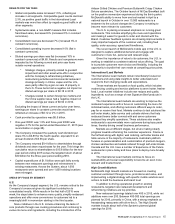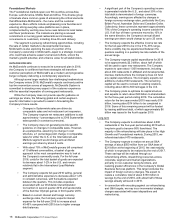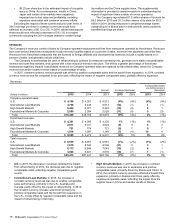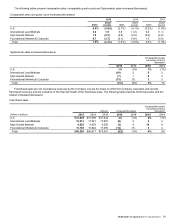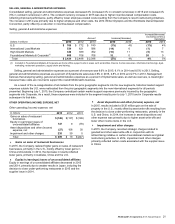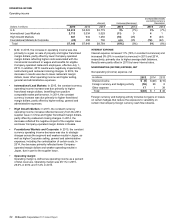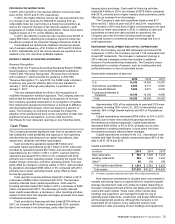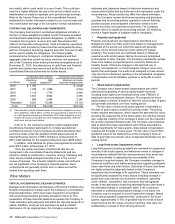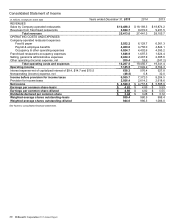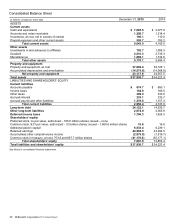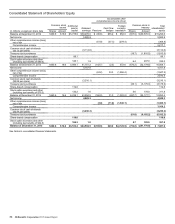McDonalds 2015 Annual Report Download - page 27
Download and view the complete annual report
Please find page 27 of the 2015 McDonalds annual report below. You can navigate through the pages in the report by either clicking on the pages listed below, or by using the keyword search tool below to find specific information within the annual report.
McDonald's Corporation 2015 Annual Report 25
Standard & Poor’s and Moody’s currently rate, with a stable
outlook, the Company’s commercial paper A-2 and P-2,
respectively; and its long-term debt BBB+ and Baa1, respectively.
To access the debt capital markets, the Company relies on credit-
rating agencies to assign short-term and long-term credit ratings.
Certain of the Company’s debt obligations contain cross-
acceleration provisions and restrictions on Company and
subsidiary mortgages and the long-term debt of certain
subsidiaries. There are no provisions in the Company’s debt
obligations that would accelerate repayment of debt as a result of
a change in credit ratings or a material adverse change in the
Company’s business. Under existing authorization from the
Company’s Board of Directors, at December 31, 2015, the
Company had $4.0 billion of authority remaining to borrow funds,
including through (i) public or private offering of debt securities;
(ii) direct borrowing from banks or other financial institutions; and
(iii) other forms of indebtedness. In addition to debt securities
available through a medium-term notes program registered with
the U.S. Securities and Exchange Commission ("SEC") and a
Global Medium-Term Notes program, the Company has
$2.5 billion available under a committed line of credit agreement
as well as authority to issue commercial paper in the U.S. and
global markets (see Debt Financing note to the consolidated
financial statements). Debt maturing in 2016 is $787 million of
long-term corporate debt. The Company plans to issue long-term
debt to refinance this maturing debt. As of December 31, 2015, the
Company's subsidiaries also had $732 million of borrowings
outstanding, primarily under uncommitted foreign currency line of
credit agreements.
The Company uses major capital markets, bank financings
and derivatives to meet its financing requirements and reduce
interest expense. The Company manages its debt portfolio in
response to changes in interest rates and foreign currency rates
by periodically retiring, redeeming and repurchasing debt,
terminating swaps and using derivatives. The Company does not
hold or issue derivatives for trading purposes. All swaps are over-
the-counter instruments.
In managing the impact of interest rate changes and foreign
currency fluctuations, the Company uses interest rate swaps and
finances in the currencies in which assets are denominated. The
Company uses foreign currency debt and derivatives to hedge the
foreign currency risk associated with certain royalties,
intercompany financings and long-term investments in foreign
subsidiaries and affiliates. This reduces the impact of fluctuating
foreign currencies on cash flows and shareholders’ equity. Total
foreign currency-denominated debt was $7.0 billion and
$5.9 billion for the years ended December 31, 2015 and 2014,
respectively. In addition, where practical, the Company’s
restaurants purchase goods and services in local currencies
resulting in natural hedges. See the Summary of significant
accounting policies note to the consolidated financial statements
related to financial instruments and hedging activities for additional
information regarding the accounting impact and use of
derivatives.
The Company does not have significant exposure to any
individual counterparty and has master agreements that contain
netting arrangements. Certain of these agreements also require
each party to post collateral if credit ratings fall below, or
aggregate exposures exceed, certain contractual limits. At
December 31, 2015, the Company was required to post an
immaterial amount of collateral due to certain derivatives having
negative positions. The Company's counterparties were not
required to post collateral on any derivative position, other than on
hedges of certain of the Company’s supplemental benefit plan
liabilities where the counterparties were required to post collateral
on their liability positions.
The Company’s net asset exposure is diversified among a
broad basket of currencies. The Company’s largest net asset
exposures (defined as foreign currency assets less foreign
currency liabilities) at year end were as follows:
Foreign currency net asset exposures
In millions of U.S. Dollars 2015 2014
Euro $3,974 $4,949
British Pounds Sterling 1,333 1,460
Australian Dollars 1,316 2,038
Canadian Dollars 1,096 1,231
Russian Ruble 396 443
The Company prepared sensitivity analyses of its financial
instruments to determine the impact of hypothetical changes in
interest rates and foreign currency exchange rates on the
Company’s results of operations, cash flows and the fair value of
its financial instruments. The interest rate analysis assumed a one
percentage point adverse change in interest rates on all financial
instruments, but did not consider the effects of the reduced level of
economic activity that could exist in such an environment. The
foreign currency rate analysis assumed that each foreign currency
rate would change by 10% in the same direction relative to the
U.S. Dollar on all financial instruments; however, the analysis did
not include the potential impact on revenues, local currency prices
or the effect of fluctuating currencies on the Company’s
anticipated foreign currency royalties and other payments received
from the markets. Based on the results of these analyses of the
Company’s financial instruments, neither a one percentage point
adverse change in interest rates from 2015 levels nor a 10%
adverse change in foreign currency rates from 2015 levels would
materially affect the Company’s results of operations, cash flows
or the fair value of its financial instruments.
LIQUIDITY
The Company has significant operations outside the U.S. where
we earn about 60% of our operating income. A significant portion
of these historical earnings are considered to be indefinitely
reinvested in foreign jurisdictions where the Company has made,
and will continue to make, substantial investments to support the
ongoing development and growth of our international operations.
Accordingly, no U.S. federal or state income taxes have been
provided on these undistributed foreign earnings. The Company's
cash and equivalents held by our foreign subsidiaries totaled
approximately $1.5 billion as of December 31, 2015. We do not
intend, nor do we foresee a need, to repatriate these funds.
Consistent with prior years, we expect existing domestic cash
and equivalents, domestic cash flows from operations, annual
repatriation of a portion of the current period's foreign earnings,
and the issuance of domestic debt to continue to be sufficient to
fund our domestic operating, investing, and financing activities.
We also continue to expect existing foreign cash and equivalents
and foreign cash flows from operations to be sufficient to fund our
foreign operating, investing, and financing activities.
In the future, should we require more capital to fund activities
in the U.S. than is generated by our domestic operations and is
available through the issuance of domestic debt, we could elect to
repatriate a greater portion of future periods' earnings from foreign
jurisdictions. This could also result in a higher effective tax rate in
the future.
While the likelihood is remote, to the extent foreign cash is
available, the Company could also elect to repatriate earnings
from foreign jurisdictions that have previously been considered to
be indefinitely reinvested. Upon distribution of those earnings in
the form of dividends or otherwise, the Company may be subject
to additional U.S. income taxes (net of an adjustment for foreign


